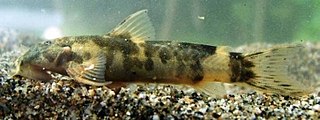
Joseph Nelson Rose was an American botanist. He was born in Union County, Indiana. His father died serving during the Civil War when Joseph Rose was a young boy. He later graduated from high school in Liberty, Indiana.
The pink corydoras is a tropical freshwater fish belonging to the subfamily Corydoradinae of the family Callichthyidae. It originates in inland waters in South America, and is found in the Meta River basin in Colombia. A maximum body length of 4.2 cm has been reported. It was named in honor of pet-book publisher Herbert R. Axelrod (1927–2017), who helped collect type series and sent it to the Senckenberg Museum in Frankfurt, Germany.
Corydoras geoffroy is a tropical freshwater fish belonging to the Corydoradinae sub-family of the family Callichthyidae. It originates in coastal rivers in South America, and is found in Suriname and French Guiana.
Britski's catfish is a tropical freshwater fish belonging to the subfamily Corydoradinae of the family Callichthyidae native to South America where it is found in the upper Paraguay River basin in Brazil. This species was formerly classified as Brochis britskii.

Astroblepus is a genus of fish in the family Astroblepidae found in South America and Panama. This genus is the only member of its family. These catfishes are primarily found in torrential streams in the Andean area. Astroblepus pholeter and A. riberae are troglobites adapted to living in subterranean water systems. These species are typically small, less than 10 cm (4 in). The largest species reaches 30 cm (1 ft). These fish have suckermouths like those of loricariids. They have two pairs of barbels, maxillary and nasal. The dorsal fin spine lacks a locking mechanism. These fish also have odontodes, tiny teeth on their skin. All species exhibit a conical, pointy type on their fin rays like that found in other loricarioids; other species also exhibit a blunt type that is only found on their skin.
Maurice Kottelat is a Swiss ichthyologist specializing in Eurasian freshwater fishes.
Gerald Robert "Gerry" Allen is an American-born Australian ichthyologist. His career began in 1963, when he spent a semester at the University of Hawaii, where he also received a PhD in marine zoology in 1971. In 1972, Allen wrote his doctoral thesis on the systematics and biology of the anemone fish.

Astroblepus chapmani is a species of catfish of the family Astroblepidae. It can be found in the Magdalena River in Colombia.
Astroblepus eigenmanni is a species of catfish of the family Astroblepidae. It can be found on Ecuador.
Astroblepus festae is a species of catfish of the family Astroblepidae. It can be found on south Ecuador.

Astroblepus grixalvii is a species of catfish of the family Astroblepidae. It can be found in Colombia and Ecuador.

Astroblepus guentheri is a carnivorous species of catfish of the family Astroblepidae. It can be found in rainforest streams in the basin of the Magdalena-Cauca rivers and in some Pacific slope rivers in Colombia. It is an uncommon and not well studied species.
Astroblepus mancoi is a species of catfish of the family Astroblepidae. It can be found on the Ucayali River on Peru.
Astroblepus mariae is a species of catfish of the family Astroblepidae. It can be found on the Meta River in Colombia and Venezuela.
Astroblepus phelpsi is a species of catfish of the family Astroblepidae. It can be found on Lake Maracaibo in Venezuela.
Astroblepus regani is a species of catfish of the family Astroblepidae. It can be found in Ecuador.
Astroblepus rengifoi is a species of catfish of the family Astroblepidae. It can be found on the Atrato River in Colombia.
Astroblepus riberae is a species of catfish of the family Astroblepidae. This cavefish is endemic to the Cajamarca region in Peru.
Astroblepus rosei is a species of catfish of the family Astroblepidae. It can be found on Cajamarca, Peru.
Astroblepus simonsii is a species of catfish of the family Astroblepidae. It can be found in Peru.





